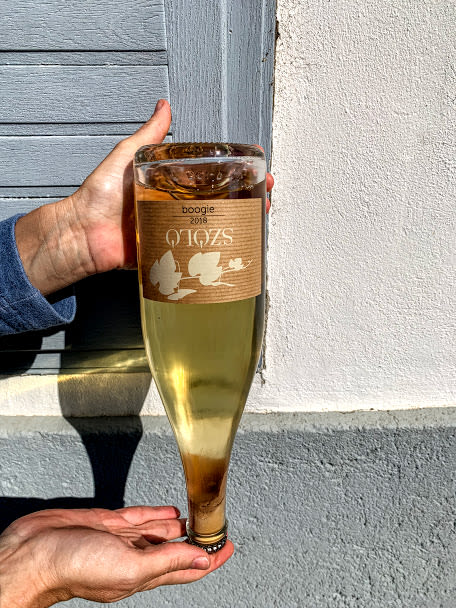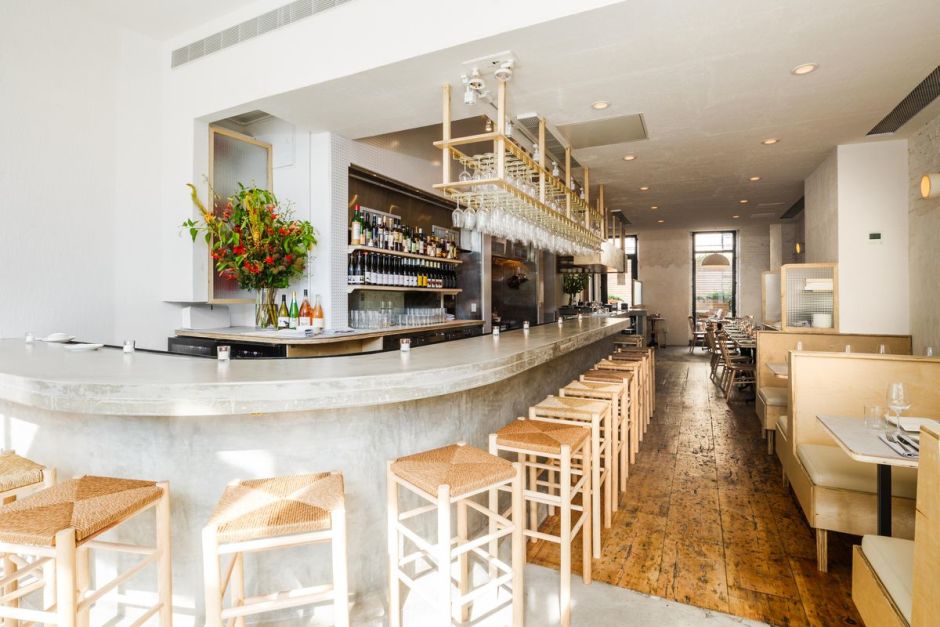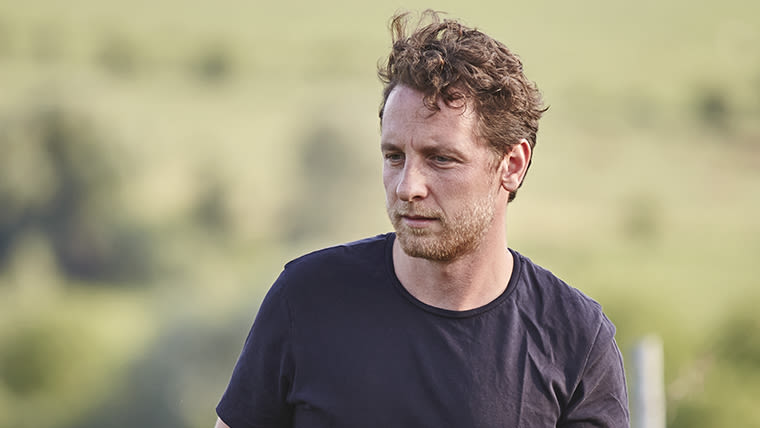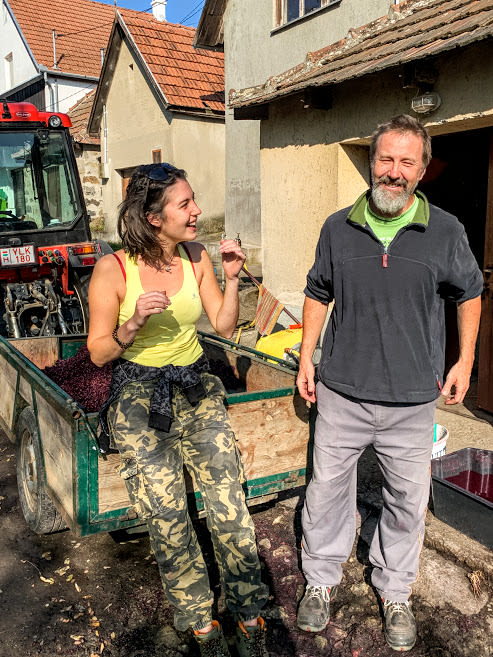For historical reasons, this wildly popular genre of winemaking went largely unnoticed in Hungary. But thanks to the country’s new crop of winemakers and plugged-in millennial tourists to Budapest, things are pointing to the next big trend.

If you've visited Budapest recently, you might have noticed that natural wines are creeping into wine lists. One of the city’s most acclaimed restaurants, Michelin-starred Borkonyha, serves natural wine from places like Spain, Slovakia, Austria, and Hungary. This growing trend is happening everywhere else, too.
What started as a niche movement among French vintners in the 1970s has ballooned into a massive international trend supercharged and disseminated by affluent, in-the-know millennials in cities like New York, Paris, Copenhagen, and Melbourne. “Do you guys have natural wine? Something a little funky?” I overheard during my recent visit to New York a seemingly well-off thirty-something ask the server while he waited for his group to arrive at Ugly Baby, a buzzy Brooklyn restaurant.
For the past decade or so, the topic of natural wine has flared up intense debates among wine enthusiasts around the world. Advocates are happy to sip wine that contains little to no additives and comes from a chemical-free farm. Real stuff, they say, that people happily drank away for centuries before the wine industry started to overprocess and manipulate wine with chemicals.
People in the other camp, however, frown upon what they believe to be an anti-scientific approach to winemaking. “If we’ve come this far in perfecting the winemaking process, why go back to the middle ages?” paraphrases a line I often hear from traditional winemakers and unfussy drinkers. Whichever side you’re on, it’s impossible to deny that natural wines have seeped into the mainstream.
What is natural wine?
Natural wine doesn’t have a precise definition, but it generally refers to wines made with little or no intervention, unlike the practice in what’s known as traditional winemaking. Natural winemakers grow grapes without the aid of pesticides and chemical fertilizers and after harvest, they more or less let Mother Nature take over.
For example, rather than using a hand-picked strain of yeast with a given flavor profile, as large-scale producers do, they let wild yeasts that naturally occur in the cellar spontaneously ferment the grape juice into wine. Also, natural wine producers skip fining and filtering in order to retain as much of the wine’s native, intrinsic flavors as possible (that’s why natural wines are hazy and have those sediments at the bottom of the glass, mainly a collection of dead yeasts). Many winemakers also do away with sulfur dioxide, a natural substance normally added to wine to prevent oxidation, spoilage, and an accidental second fermentation inside the bottle.
As a result of all this, natural wines have a more unpredictable taste than traditional bottles. “Funky” is how many people describe them, hinting at their often noticeable gamey, earthy aromas. There’s a cliche that natural wines have a “barnyard” smell or mousiness from unwanted wild yeasts afflicting the wines (for traditional winemakers this isn’t an issue since the added sulfur kills off bacteria). In reality, myriad clean and wonderful natural wines exist. Natural wines are usually lower in alcohol and higher in acidity (low pH) than traditional wines because a high-acid environment reduces the risk of undesirable yeasts infecting the wine.
There’s also a cultural aspect to natural wines: It’s what the cool kids drink these days. When you order natural wine, you’re signaling to the outside world is that you’re up-to-date and that you support sustainable farming and family businesses.
Natural wines in Hungary
Armed with this information, I decided to take a deeper look at Hungary’s natural wines. I spoke with leading Budapest sommeliers, and winemakers across different wine regions, including Badacsony in western Hungary, Mátra in the northeast, and the famous Tokaj villages in eastern Hungary.
“We are coming to this late,” said István Bencze, one of the movement’s pioneers. “The fact that Hungary has a long winemaking history actually makes it harder to adopt new approaches.” But if that were true, I pushed back, how come France and Italy are pioneers of natural wine? “Communism didn’t decimate their wine industry. For the past three decades, Hungary has been working on rebuilding itself. There was no time for natural wines.”
I also noted how much hostility traditional winemakers feel toward the “naturals.” Like others, they predict that the hype will ultimately run its course. (There were those too, who, off the record, admitted that at their levels of production they simply can’t afford to make inconsistent wines, even if some naturals are pretty good.)
Since the boundaries are blurred, I don’t have a precise figure for the number of natural winemakers in Hungary today, but it’s still low. Especially few are those who truly align with the principles of the movement, especially of being environmentally friendly and sustainable, rather than just trying to capitalize on its popularity, for example, by putting out a bubbly pet nat. At the same time, natural wine is becoming all the rage among younger winemakers who’re just starting out. “I get calls all the time from new wineries asking me to teach them” said Bencze.

Tourism to Budapest is another driver. Cool foreign millennials arriving want to try the local natural wines. “We get a lot more interest in naturals now than we did five years ago,” says Krisztián Juhász, head sommelier at Winekitchen restaurant. At the end of 2019, Máté Szekeres and Regina Ujszászi launched Portobello, a dedicated natural wine bar in downtown Budapest. TÁBLA, a natural wine bar and store inside the hip Jewish Quarter of Budapest, holds weekly natural wine tastings in partnership with Szofi by nature, a local distributor. Several more openings are expected in 2020, according to Bencze.
Hungarian natural wines in New York City
Despite the growing scene at home, I noticed during my trip that New York City’s natural wine bars served practically no Hungarian wines. You can run into a few, but there’s none at Four Horsemen, arguably New York’s most prominent natural wine bar, and things aren’t much better at Frenchette, Ruffian, and June, places with strong natural wine programs.
Considering that the U.S. is the world’s most quickly growing market for natural wine, this is surprising. Other Central European countries like Austria and Slovenia, and even the Czech Republic, which historically wasn’t much of a wine producer, are better represented. This is unfortunate, because American consumers are increasingly seeking out more “exotic” natural wines from places like Central Europe while Hungary is nowhere to be seen.
“The truth is that I haven’t been shown any Hungarian natural wines with the exception of Meinklang whose vines are in Hungary,” said Justin Chearno, the wine director of Four Horsemen. The Meinklang winery itself, however is located in Austria. “We love Central European wines here and look forward to seeing more of them in the market soon.”
Patrick Cournot, wine director of Ruffian bar in New York’s East Village neighborhood, also chalks up the lack of Hungarian wines to their unavailability, and also to changing consumer preferences. “Our millennial customers prefer lighter savory reds (unlike our parents) and Austria's cult popularity has picked up because of it,” said Cournot. “Austria has also become hip because they have a commercially marketable product in the quaffable Grüner Veltliner … Austrian wines are the most available from the region.”

But some signs point to a potential upswing for Hungary. Cournot pointed to Somló, a small wine region in western Hungary known for its high-minerality wines, but here too, supply is an issue. “The smoky profile works well with our food. We can't find consistent options but the wines we've had were great (Fekete Béla back in the day and Somlói Vándor are all we've gotten good supply of). More would be a good thing.”
LaLou, a recently opened hip natural wine in Brooklyn run by industry heavyweights, serves Hungarian wines by Homonna, Pálffy, and Szászi. “These wines are distinctive, pure, and speak of the place they came from. When we built out the initial list for our opening, I knew we had to feature these wines,” said partner Dave Foss, who tasted them during a trip to Hungary. “To me, Hungarian natural wines tend to be less wild than Czech wines and a bit richer than some Austrian natural wines across the border in Burgenland.”
Three Hungarian natural wine producers to watch
The winemakers below are each based in a different region, but an unquestioning dedication to quality wines, chemical-free farming, and low-intervention production unites these family wineries. (The second part of this series will feature three more producers who are also at the forefront of the natural wine movement in Hungary.)
Bencze Birtok (Szentgyörgyhegy, Badacsony wine region)

Bencze, 37, started his career as a software developer before turning to wines in 2011 with support from his family; he’s considered one of Hungary’s first natural wine producers. His passion can sometimes border on the zeal of fanaticism. “I started reading [father of biodynamic farming Rudolf] Steiner, and all the other literature, then I visited winemakers in Slovenia and France, and at some point I knew there was no going back to chemical farming,” Bencze said.
“In the beginning, I would just stand in the vineyard, observing and listening. I can still hear the chirp of crickets reverberating in my ear. They appeared after we got rid of pesticides. Vineyards that use chemicals are dead silent.”
Bencze’s 16-hectare (40-acre) vineyard is located in the scenic Balaton Uplands, about two-hours from Budapest by car, overlooking Central Europe’s largest freshwater lake. He cultivates riesling, pinot noir, and more recently indigenous Hungarian varieties too like furmint, hárslevelű, and kéknyelű. He switched to biodynamic farming in 2014 and went “fully natural” last year. “You might think I’m too esoteric, but I’m convinced that wine expresses every little nuance about the way it was cultivated. I can detect even the smallest amount of sulfur in wine these days.”
This year, Bencze started Lees Brothers, a wine distribution company in Hungary specializing in natural wines. Also, his wines will soon appear on the U.S. market through natural wine importer Jenny & François Selections.
My favorite: Bencze Pinot Noir, 2018
Gábor Karner Winery (Szűcsi; Mátra wine region)

Gábor Karner grew up in one of those drab, Soviet-style high rises in the Budapest outskirts, but he got fed up with big-city life and moved to the countryside with his wife in 1995. Their house came with a few rows of vines and a neighbor encouraged him to make wine from the grapes. What started as a hobby soon became an obsession.
In 2003, Karner bought a small, one-hectare (two-and-a-half-acre) vineyard in Szűcsi, a tiny village in Mátra in northeastern Hungary. It was one of the less sexy of Hungary’s 22 wine regions at the time, but he didn’t mind. “I wouldn’t swap this for anything. The volcanic bedrock gives wonderful minerality to our wines while the chalky soil maintains their acidity.”
In the beginning, Karner was so poor that sometimes he would sleep in the attic of a wooden shack next to his small winery to save money on gas. He had to learn everything on his own. He was pouring over wine publications and inviting vintners to Szűcsi, trying to soak up everything he heard. Gradually, he developed a vision.
He kept yields low and turned to chemical-free farming. He didn’t fine or filter his wine. He avoided mechanical processes, explaining that “pumping can kill the structure of wine.” He limited sulfur levels. He also adopted some aspects of biodynamic viticulture that may sound a little far-fetched when you first hear them (“we pay attention to the tide tables and moon cycles when we bottle the wine”), but the results speak for themselves. Accolades began to pour in, and today Karner sells his wines to Michelin-starred restaurants around the world.
Budapest sommeliers consider his kékfrankos varietal wine to be one of the best in Hungary. (Kékfankos is a red grape variety native to Hungary and Austria whose German moniker, Blaufränkisch, might sound more familiar.) “It’s the perfect grape. It has everything. Good acidity, and a subtle taste that leaves room for the soil to express itself. Like pinot noir in Burgundy,” said Karner.
In 2017, Karner completely stopped using sulfur. “Adding sulfur to wine is like pruning the crown of an oak tree to shape by cutting off all of its side branches,” he explained. When I arrived in Szűcsi this fall to visit him, he and his daughter, Fanni, were elbow-deep in a vat of white grapes.
“We’re making orange wine” said Fanni, who was just finishing her college degree in viticulture and enology, and seemed as passionate about wines as her father. “I spent the summer working in the vineyard. It’s very calming to be out there.” By orange wine, she was referring to a type of white wine where the must is left in contact with the grape skins, lending it an orange hue. Like natural wines, orange wines have been extremely fashionable lately. But Gábor Karner thinks they’re more than just a fad. “The skins add a layer of complexity. They make the wine more exciting.”
My favorite: Karner Gábor Szőlőkert utca 2 Olaszrizling (Welschriesling), 2018
Szóló Winery (Tállya; Tokaj wine region)

This family winery is the project of husband-and-wife duo, Tímea and Tamás Éless, who brings a decidedly new approach to winemaking in Tokaj, Hungary’s most prominent wine region best known for its sweet aszú wines. The region’s long history looming over their heads can feel intimidating at times, confesses Tímea.
Local winemakers often frown at their methods (which uses no fining and filtering) and winemaking equipment. The latter includes a large clay qvevri jar, which is a traditional fermentation vessel originating in Georgia, and an egg-shaped concrete vat, which naturally stirs the lees and sediments back into wine, thereby enhancing its flavor. Tamás, who is a partner at a Budapest-based law firm, is up to date on the latest global winemaking trends and likes to experiment.
The couple’s 10-hectare (25-acre) vineyard is located in Tállya, one of the top villages of Tokaj (a landmark 18th-century classification system designated many first-class parcels here). Tímea, who hails from Tállya and made her first wine here on a vineyard she inherited from her grandparents, admitted that things are still a work in progress.
“We’re farming organically and moving toward sulfur-free natural wines, but not everything turns out as planned. And that’s okay, it’s a learning process.” Despite her modesty, most fine dining restaurants in Budapest’s already carry their bottles.
Apart from the wines, Tímea and Tamás are a force for good in Tállya. This sleepy village is located in one of the poorest regions of Hungary and is plagued by high unemployment and a declining population. Countless “for sale” signs are duct-taped on dilapidated buildings.
Despite this, they beautifully renovated an 18th century building in the center of town, which currently serves as their base. They also purchased an abandoned lot across the street where workers were laying the foundations of a modern winery during my visit this past September. As I said goodbye to them, it was impossible not to feel inspired.
My favorite: Szóló Puro (Furmint), 2016